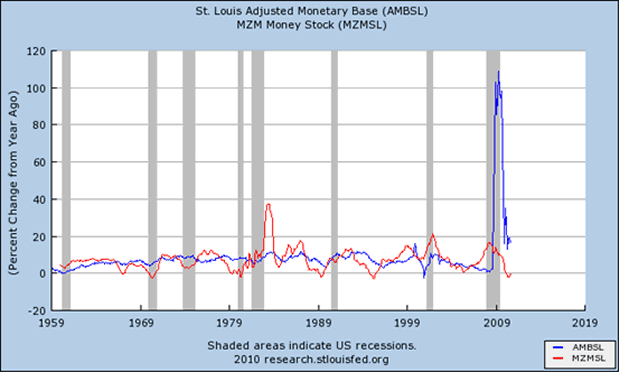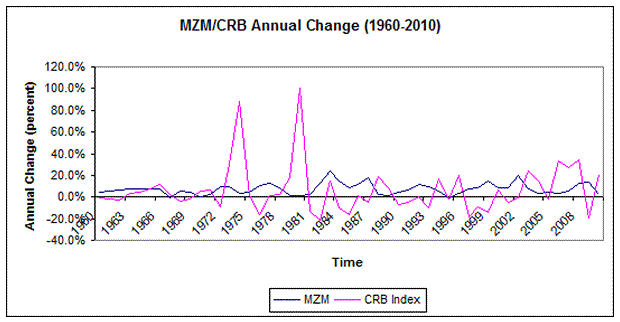Making Sense of the Money Supply
Economics / Money Supply Nov 03, 2010 - 06:34 AM GMTBy: Chris_Riley
 With the Fed’s rapid expansion of the monetary base in recent years, many commentators have pointed out that this has not led to growth in the money supply and hence the Fed is powerless to deal with “deflationary” forces in the economy.
With the Fed’s rapid expansion of the monetary base in recent years, many commentators have pointed out that this has not led to growth in the money supply and hence the Fed is powerless to deal with “deflationary” forces in the economy.

The first point to note is that rapid expansion in the monetary base has not yet led to runaway monetary growth. The expansion in the monetary base has been used to prevent the money supply from collapsing. This does not preclude the possibility that money supply growth will runaway in the future, particularly if the Fed is left holding assets that it does not, or cannot, liquidate quickly. However, is there any direct link between money supply growth and price inflation?

We see that the relationship between monetary growth and commodity price increases is not particularly strong. For example, there was a big increase in commodity prices in the 1970’s and yet monetary growth was not unusually rapid, whilst the 1980’s and the 1990’s were times of negative commodity price growth, even though monetary growth was substantial through these decades. So what is going on here: what is actually driving commodity prices?
The statistic that should really concern us is monetary growth, not backed by economic growth. As the economy grows through productivity increases; prices should decrease. The only way to prevent this decrease is through monetary growth. Monetary growth in line with economic growth will result in stable prices; monetary growth above economic growth will lead to increases in prices. So we had rapid increases in commodity prices in the 1970’s in spite of tepid monetary growth because productivity was decreasing. We had negative growth in commodity prices in the 1980’s & 1990’s because productivity was increasing, even as the money supply was increasing at a slower rate.
So now we have a clear understanding of the relationship between monetary growth and prices; how do we explain the explosion in commodity prices this decade? Although monetary growth has been in line with previous policy over the last 30 years, we are seeing a decline in productivity in western economies as governments tax and regulate economies more and more. This dynamic is, in itself, able to cause increases in commodity prices. The Fed should have allowed the money supply to collapse in line with productivity in order to stabilise commodity prices. But they expressly avoided this by expanding the monetary base, so commodity prices will continue to rise.
By Chris Riley
For more articles and charts, check-out my new website: www.goldbugz.co.uk
© 2010 Copyright Chris Riley - All Rights Reserved
Disclaimer: The views expressed in this article are those of the author and may not reflect those of Neptune Global Holdings LLC (Neptune). The author has made every effort to ensure accuracy of information provided; however, neither Neptune Global Holdings LLC nor the author can guarantee such accuracy. This article is strictly for informational purposes only and a sampling of diverse editorial opinion. It is not a solicitation to make any exchange in precious metal products, commodities, securities or other financial instruments. Neptune Global Holdings LLC and the author of this article do not accept culpability for losses and/ or damages arising from the use of this publication. Neptune does not act as, nor offer the services of, an investment advisor. Individuals should conduct their own due diligence before making any investment choices.
© 2005-2022 http://www.MarketOracle.co.uk - The Market Oracle is a FREE Daily Financial Markets Analysis & Forecasting online publication.



